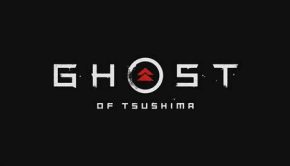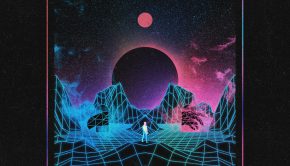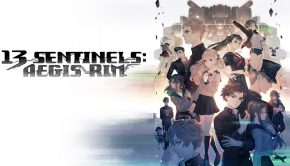Basiscape Interview: Caravan Stories
Basiscape has been responsible for a lot of music in the past few years, from Valkyria Chronicles 4, by Hitoshi Sakimoto, to various Vanillaware works, such as the PS4 re-releases of Dragon’s Crown and Odin Sphere: Leifthrasir, which featured orchestrations and new compositions by other members of Sakimoto’s company. Yoshimi Kudo, known for his work on Raiden V, is joined by Mitsuhiro Kaneda, known for his work on Grand Kingdom, and Rikako Watanabe, one of the newest members of Basiscape.
In this interview with Yoshimi Kudo, Mitsuhiro Kaneda, and Rikako Watanabe, they reflect on some of their previous works and primarily discuss their work on the MMORPG Caravan Stories and how they brought the world of Iyarr to life.
Interview Credits
Interview Subject: Yoshimi Kudo, Mitsuhiro Kaneda, Rikako Watanabe
Interviewer: Don Kotowski
Editor: Don Kotowski
Translation: Basiscape
Translation Editor: Derek Heemsbergen
Coordination: Basiscape
Interview Content
VGMO: Thank you for taking the time to speak with our site today about the music of Caravan Stories. Before we begin, Kudo-san, Kaneda-san, and Watanabe-san, could you briefly discuss some of your favorite projects you’ve worked on since last we spoke? Watanabe-san, since this is the first time you’ve spoken with us, could you tell us about your musical background and influences, as well as what joining Basiscape has meant for you?
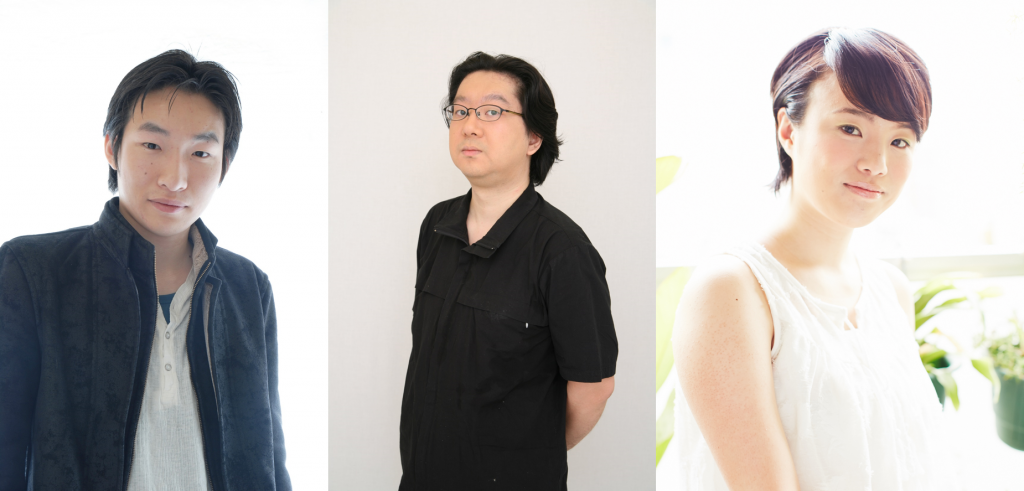
Yoshimi Kudo: My favorite project as a Basiscape team member was Muramasa: The Demon Blade, while my favorite project out of those I composed is Raiden V. I am also passionate about the GITADORA series, which I contributed to in a guest capacity. Each of these roles and programs led me to make new discoveries about myself as a composer.
Mitsuhiro Kaneda: I have some favorites, but this time I’d like to talk about Muramasa: Genroku Legends, which has never been specifically mentioned until now. I feel very enthusiastic about having been able to take charge of this project. My confidence in this work stems from the level of detail I was able to achieve by using musical motifs that evoked Shinto and Buddhist sensibilities in tandem with the game scenario. The last boss theme in particular continues to resonate with me–I still remember seeing the boss’s fierce attack patterns as they were under development, and the stress of living up to its visual grandeur weighed on me heavily. Luckily, I was able to use the feeling of Jerry Goldsmith-style brass and a “We Will Rock You” rhythm, given to me in advance as a creative reference, to invigorate my compositions. It all turned out well in the end, I think, and it ended up one of my favorite works.
Rikako Watanabe: It’s hard to definitively call one the “best,” because each project has different memories associated with it, but Caravan Stories is the first project I’ve been involved in with Basiscape. As such, my personal feelings for it are the deepest, because I think of it as the first friend I met on a new adventure.
As for my musical background, I’ve always liked games and game music since I was a child, so the music I’m influenced by is from my favorite games. This is especially true for the music of Kumi Tanioka, who worked on Final Fantasy XI and Final Fantasy Crystal Chronicles, and the music of Hayato Asano, who worked on the Atelier series and Blue Reflection. In essence, belonging to Basiscape is special to me because our ways of making music are in harmony. I think the notes themselves are more important than anything where music is concerned, so it’s nice to have an environment that understands where I’m coming from. That means I can make the most of my time and effort here.
VGMO: The Caravan Stories Original Soundtrack releases were grouped according to the races found in the game. Most composers on the project were each responsible for a large portion of a single race. However, Caravan Stories Original Soundtrack Vol. 2, which dealt with the Human race, was more of a collaborative effort. What elements did you want to incorporate into the music of the Human areas to make it cohesive? Could you discuss your contributions to this particular volume?
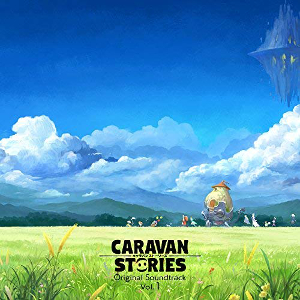
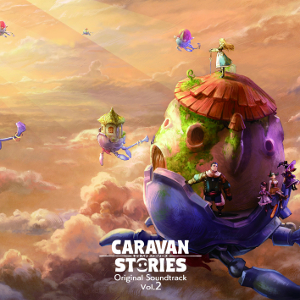
Yoshimi Kudo: Humans as a race are more diverse than other races, and thus tend to be what most Caravan Stories players gravitate towards first. It was also the first group we set out to compose music for, and the Basiscape team worked together with [Caravan Stories developer] Aiming, Inc. using a couple of songs I composed in advance to create a unified musical theme. We conceptualized the game’s overall feeling and fantasy worldview as a transparent image with chords and melodies.
I think our collaborative approach, strengthened by the talents of multiple composers, fits well with the Human race as depicted in Caravan Stories: one race, united by diversity.
Mitsuhiro Kaneda: I personally wanted to achieve a “baseline” feeling with Human races, while at the same time evoking ideas tied to adventure, roaming, and kindness. This is especially true of field songs like “Eastern Part of Denon Hill” and “Waterling Main Road.” In the other field songs, I basically tried to express the atmosphere of the area without any especially unusual musical motifs.
Rikako Watanabe: The only music I worked on in the Human area was the arrangement for nighttime music. I was most conscious of pieces where I was dedicated to evoking landscapes. The Humans in Caravan Stories closely resemble us in the real world, making them feel quite familiar. To highlight that, I wrote music thinking that it would be nice if the boundaries between the player and the character became thinner by not going out of my way to explicitly explain what it means to have “Human” traits.
VGMO: Kudo-san, you were the sound director for the game, and you were also largely responsible for music in the Dwarf- and lizard-related soundtrack releases. With the Dwarf-related music, mallet percussion seems to be a consistent theme. With the lizard-related areas, electronic beats are largely found in your contributions. What led to these types of compositional choices, and could you discuss some of your favorites from Caravan Stories Original Soundtracks Vol. 4 and Vol. 7?
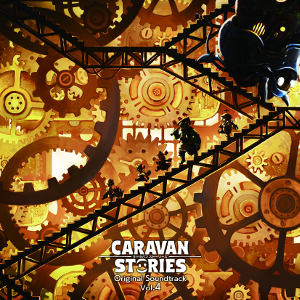
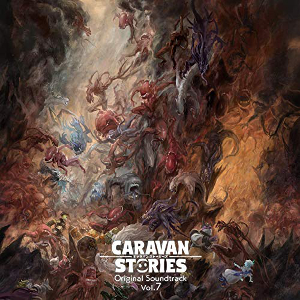
Yoshimi Kudo: For the Dwarf race, we constructed repetitions and sequential phrases with sixteenth notes as characteristic elements. This was conceptualized to evoke Dwarven characteristics, such as buildings with gears and steampunk mechanisms. Also, there are many songs that are relatively bright and energetic because they are influenced by specific Dwarf characters that appear in-game, so I think the nuance of this work is slightly different from the stereotypical Dwarf image.
For the lizard race, our approach was quite unique for the realm of fantasy music. This uniqueness is captured in music, rather than in the biological and cultural features of the lizards themselves, as characterized by an environment in which the lizards in Caravan Stories are constantly threatened by a variant race called the collapter. When I met with game director Takayashiki-san, he told me he wanted both tension and exhilaration featured prominently in their overall musical theme. Although I was quite surprised when he presented shooting game music as a reference, integrating its rhythmic elements with the world of Caravan Stories resulted in some fascinating compositions.
VGMO: Kaneda-san, you were largely responsible for the Ork-related music, for which war drums are a common instrument. What was your approach to the area and battle themes present in this volume, and could you highlight some of your favorites? In addition, please feel free to discuss your contributions to Vol. 4 and Vol. 8.
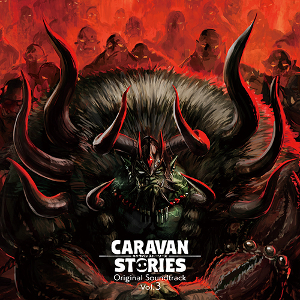
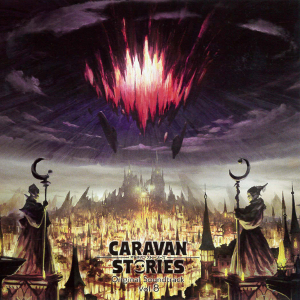
Mitsuhiro Kaneda: So as you are aware, I was in charge of composing for the Orks. The thematic guidelines I received from Kudo-san were to evoke “muddiness,” “roughness,” and to use “ethnic and percussive instruments.” This meant that many songs were produced mainly by orchestra and layered heavily. I leaned a little more orthodox in my non-Ork compositions, with orchestra-style battle music featuring understated ethnic instruments. I was in charge of “Ghelbours Foothills” in Vol. 4 and “Demon Transformation,” “Chamber of Spirits and Training,” “Crescent Hot Spring Town,” “Trumbull Dominion,” “Claw Knights,” and others in Vol. 8. “Trumbull Dominion” has a slightly different approach than the rest, emphasizing the sense of thrill and suspense of the modern jazz orchestra style, to which I added ad-lib piano.
VGMO: Watanabe-san, you were largely responsible for the Gessy-related music, which features a consistent tropical vibe. What did you feel were the challenges in creating music for this area, and could you talk about your approach to “Canyari Mine”? It is the only mine-related track not composed by Kazuki Higashihara-san and is much more melodic in focus. What led to this decision?
Rikako Watanabe: I took full advantage of the Gessy race’s animalistic characteristics, colorful scenery like the seaside and dense forest, and their pleasant and optimistic personalities into consideration here. Communicating their differences, but also the fact that they are still residents of the same world as all the other races, has always been a challenge in producing Gessy area music.
My early sketches were more dependent on the atmosphere and ethnicity of the southern country, which was too realistic to look like somewhere on Earth. I had difficulty finding the right balance in my compositions to make sure they weren’t too in line with the rest of the Caravan Stories world–otherwise, they would have lacked that intangible Gessy flavor. Leveraging the feel of places common to other tribal areas, such as the mines, was an important point under such circumstances.
By featuring a melody that connects to other races–but not too overtly–while maintaining its own unique identity, it becomes possible to draw out the uniqueness of that race elsewhere. It’s like seeing a new word and being able to guess at its meaning thanks to context clues. That’s sort of how I conceptualize the thread that runs through all of the Gessy music.
VGMO: Kudo-san, the music for the Elf-related areas is more piano-focused. Would you be able to discuss your general approach to the music for these sections? Watanabe-san, since you also contributed to this volume, would you be able to discuss your approach to the music as well?
Yoshimi Kudo: In the Elf area, which features a high fantasy atmosphere, we chose to make the music “transparent” by mainly utilizing piano and chorus. The elements of this minimal approach to music and a number of mysterious chords were used to reflect the atmosphere unique to the Elf area while differentiating it from other areas.
Rikako Watanabe: The Elf area is one of the most fantastic places in [Caravan Stories’ world of] Iyarr. In “Glenmore Fault Valley” (both daytime and nighttime) and “Aleia,” which I oversaw, I minimized the rhythmic parts as much as possible to give a soft impression, and I repeated the modulation to create a mysterious atmosphere. I wrote a lot of minor tunes, as I needed to move the song with the flow of notes by reducing the number of rhythmic steps and percussive beats. Listen well and you should be able to find them!
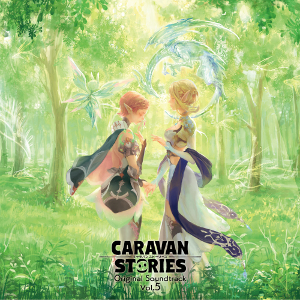
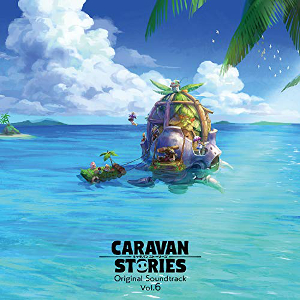
VGMO: Much of the additional battle music, not strictly related to a particular race, is featured in Vols. 1, 7, and 8 of the soundtrack releases. Could you talk about some of your contributions to these volumes, Kudo-san and Kaneda-san, as well as which styles these more broadly applied battle themes utilize?
Yoshimi Kudo: Battle music, which doesn’t belong to any one race, is divided into general-purpose themes, specific event themes, and boss character themes. As for the general-purpose tracks, we start with an orthodox orchestra that works with any race to follow the sound that is the main axis of Caravan Stories as a whole. For example, in “Battle with Demon” and “Assault on Enigma,” I aimed for a magnificent and lush sound using chorus to symbolize the evil existence that threatens the peace of the world.
Mitsuhiro Kaneda: The chorus we used was recorded in Australia. We featured it in the boss dragon song of the ancient dragon series using a special bit of programming. You can hear it in the track “Chamber of Spirits and Training” in Vol. 8; we tried to highlight a difference in tension between the pre-battle phase and the mid-battle phase by adding a speed fluctuation element to the music. The end result falls somewhere between a Hollywood orchestra composition and what I would conceptualize as a Japanese RPG orchestra piece.
VGMO: Kudo-san, most of the Caravan Stories soundtrack releases also have a dedicated vocal theme attached to them. From my understanding, these tunes are used in side quest events featured in the game and range in style from pop to heavy metal and even opera. What led to some of these design decisions and could you discuss some of your favorite contributions?
Yoshimi Kudo: For the vocal themes, I was initially thinking we should feature something like a traditional song that matched the worldview, or something in an acoustic style. Once development progressed and the range of diversity for each character came to light, however, I started to see the allure of featuring more colorful music styles. I tried to incorporate various genres of vocal themes to emphasize each character’s individuality. This is a unique sort of “spice” that could only be achieved because the worldview was been set throughout the game’s field and battle music. Personally, I like the opera-style music we recorded for Vol. 6.
VGMO: Kudo-san, Caravan Stories features a variety of special event-related music, much of which you were responsible for. Could you talk about your inspirations and approaches to the music for these types of events, like the operatic Halloween-related tunes?
Yoshimi Kudo: A story closely linked to the characters and setting of the main story is developed for each event within Caravan Stories. It is arranged in such a way that the music of Caravan Stories can be properly represented while the narrative of each event is pushed forward. Using an easy-to-understand method, we work to prepare arrangements that emphasize the features and musical style for each event while leaving the main melody, “Caravan Trip,” flowing on the title screen.
VGMO: Lastly, Kudo-san, most of the game’s races have an arrangement of “Sailing to the City of Freedom” on their respective soundtracks. How did you incorporate the various races’ related instrumentation and stylistic feel in the music? Kaneda-san, you were responsible for the “Free City of Nero” tune. How did you approach this tune, and what qualities in the composition do you feel best convey this feeling of freedom?
Yoshimi Kudo: In “Sailing to the City of Freedom,” the first half of the song uses the arrangement of the main theme in each race’s style. As we started this piece at the stage when all music for the races had already come out, we incorporated and arranged each composer’s sound for their respective races into the tracks. This song is used at milestones in each race’s story, as well as to look back on their adventures so far. I wrote melodies and musical developments that evoke a feeling of hope and potential for future adventures.
Mitsuhiro Kaneda: When I consulted with Kudo-san, he advised me to make “Free City of Nero” evoke an image of a bustling town. There was no 3D model data at the beginning of production, but I created the first half using the image of a town with a wharf. However, the piece is on the lengthy side, so in the second half, I tried to introduce a relaxed atmosphere in my own way. That ended up giving it something of a fantastic vibe, so thanks to the freedom I was given in composing this piece, the music ended up with its own sort of “free” feeling.
VGMO: Once again, thank you so much for this interview, Kudo-san, Kaneda-san, and Watanabe-san. Is there anything you would like to tell the fans of your works or any hint as to what can we expect from you in the future?
Yoshimi Kudo: By fusing game and music into one cohesive whole, I will strive to create more appealing and unforgettable experiences for players everywhere. There are already a lot of great games and game soundtracks out there. My goal is to stay involved in contributing to that world by sending players on fresh and interesting adventures through the sound of my music.
Mitsuhiro Kaneda: I will do my utmost to continue producing quality game music, both now and in the future.
Rikako Watanabe: One of the best parts of being a creator is communicating the fun we have creating to the people who listen to our compositions. I respect composers whose enthusiasm and passion comes through clearly in their music. Even when there are unseen struggles behind the scenes, the fact that such music is produced from the heart has the power to lift up both listener and composer alike. I want to continue facing my own music with enough energy and passion to bestow that same feeling unto you.
Posted on July 24, 2019 by Don Kotowski. Last modified on July 24, 2019.

